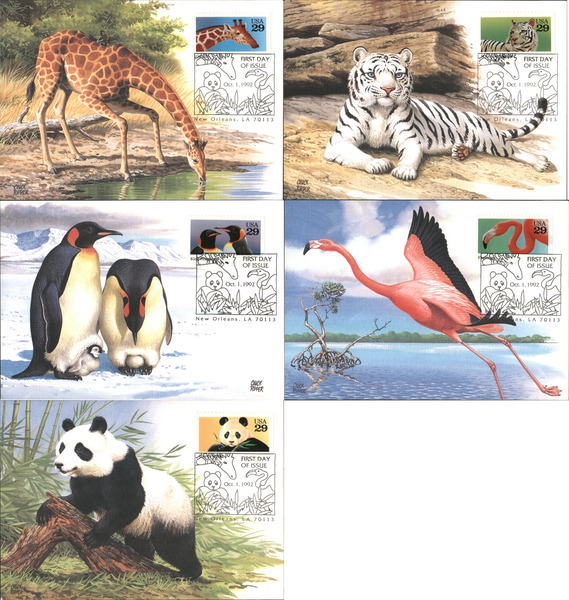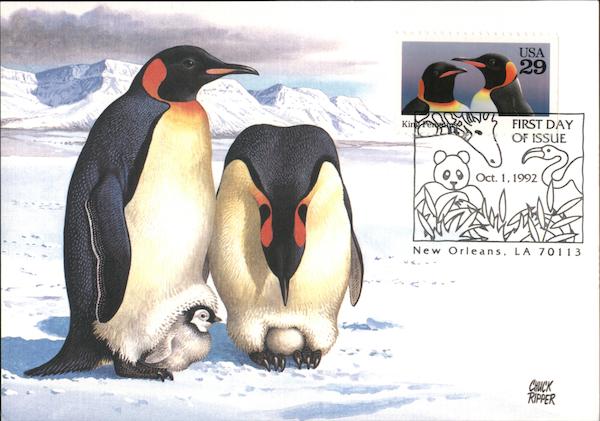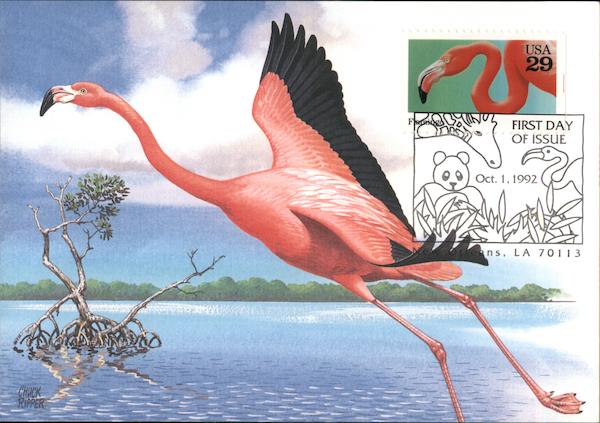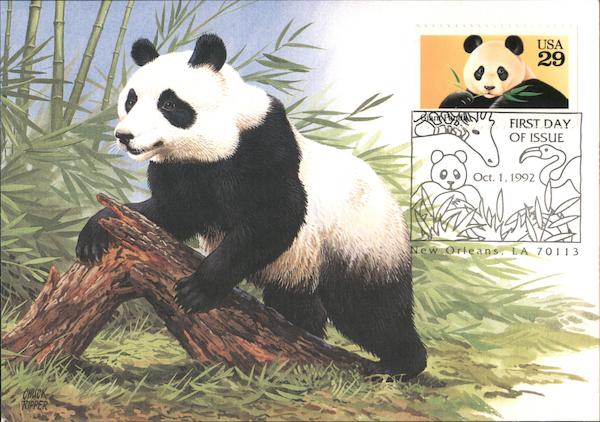Set of 5: 1992 New Orleans Zoo Animals Series
Front:
29
FIRST DAY
OF ISSUE
Oct. 1,1992
New Orleans, LA 70113
CHÚCK
RIPPER
29
FIRST DAY
OF ISSUE
Oct. 1, 1992
Www. Orleans, LA 113
CHUCK
RIPPER
29
King Per
FIRST DAY
OF ISSUE
Oct. 1,1992
New Orleans, LA 70113
CHUCK
RIPPER
29
Flening
FIRST DAY
OF ISSUE
Oct. 1, 1992
ans, LA 701 1 3
CHUCK
RIPPER
29
Bn Nos FIRST DAY
OF ISSUE
Oct. 1, 1992
New Orleans, LA 70 1 1 3
CHUICK
RIPPER
Back:
GIRAFFE
First Day of Issue: October 1, 1992
First Issue Location: New Orleans, Louisiana
Buzzards soar high above the savannah, searching for
carrion. Seeking prey, a cheetah scans the horizon. Lions
nap in the afternoon sun, while Cape buffalo seek the
coolness of area water holes. Many animals live in Africa,
but none more unique than the giraffe. Often called “the
animal built by committee," the giraffe looks as if it was
put together from spare parts. As ungainly as it may
appear, the giraffe is nevertheless one of the most wide-
spread, successful herbivores of the African plains. Its
extremely long neck and forelegs allow the giraffe to
access foliage beyond the reach of other mammals. It has
a tongue that can extend 18 inches to gather food, and
plate-sized hooves which it uses as weapons to defend its
young. A kick from the front feet of a giraffe can quickly
kill a lion. While its senses of hearing and smell are highly
developed, the giraffe's most acute sense is sight.
No. 92-121
First Day of Issue Postcard Collection
©1992 Fleetwood® Cheyenne, WY 82008-0001
Original painting for the First Day of Issue Postcard by Chuck Ripper
Heetwood
OFFICIAL FIRST DAY OF ISSUE POSTCARD
NATIONAL WILDLIFE FEDERATION
BENGAL TIGER
First Day of Issue: October 1, 1992
First Issue Location: New Orleans, Louisiana
Patience, cunning, and remarkable physical capabilities
make the tiger one of the most efficient and deadly
predators in the world. Exaggerated hind limbs allow it to
leap great distances. Heavily muscled forelimbs and
shoulders, coupled with forepaws equipped with long,
razor-sharp claws, enable the tiger to grab and bring
down prey as large as a young rhino. The tiger has
powerful jaws, and potentially fatal bites are quickly
delivered by long, somewhat flattened canines. A patient
and solitary hunter, the tiger stalks its prey while con-
cealed in available cover. Crouching, the tiger methodi-
cally moves one paw in front of the other as it gradually
moves closer to its target. Pausing frequently to raise its
head above the foliage and assess its position, the tiger
will swing its tail slowly back and forth. Having closed the
distance, the tiger gathers itself up and mounts a furious
charge — usually from behind or to the side — most often
reaching its prey within a few bounds and knocking it
from its feet.
No. 92-122
First Day of Issue Postcard Collection™
©1992 Fleetwood® Cheyenne, WY 82008-0001
Original painting for the First Day of Issue Postcard by Chuck Ripper
Heetwood
OFFICIAL FIRST DAY OF ISSUE POSTCARD
NATIONAL WILDLIFE FEDERATION
KING PENGUIN
First Day of Issue: October 1, 1992
First Issue Location: New Orleans, Louisiana
The King Penguin is a flightless bird inhabiting the far
reaches of the Southern Hemisphere. While the family is
associated with Antarctica, only two species – the
Adélie and the Emperor — are common to or reach this
frigid continent. The other species of penguins can be
found along the cool southern coasts of Africa, New
Zealand, Australia and South America. Despite its clumsy
gait and somewhat comical appearance, the King
Penguin is ideally adapted to life in the subantarctic.
During the process of evolution, its wings have devel-
oped into modified flippers which propel the bird through
the water. Its feathers are comprised of fluffy filaments
which make them virtually water-proof, and a thick layer
of blubber provides additional insulation. The King Pen-
guin is sustained on a diet of fish, crustaceans and squid,
and remains at sea for weeks at a time to feed. Basically
defenseless, this bird is also the favorite fare of marine
carnivores such as the Orca and Leopard Seal.
No. 92-123
First Day of Issue Postcard Collection™
©1992 Fleetwood® Cheyenne, WY 82008-0001
Original painting for the First Day of Issue Postcard by Chuck Ripper
Heetwood
OFFICIAL FIRST DAY OF ISSUE POSTCARD
NATIONAL WILDLIFE FEDERATION
GREATER FLAMINGOS
First Day of Issue: October 1, 1992
First Issue Location: New Orleans, Louisiana
Flamingos are strikingly beautiful birds that feed on small
aquatic animals. Their long legs and necks allow them to
wade and feed in relatively deep water. They have filter-
like beaks which enable them to sift their food from salt
lakes and brackish lagoons. Flamingos are long-lived
birds — some zoo specimens have lived more than 30
years that develop slowly. They are not fully grown
until their second year, and do not breed until their sixth.
Breeding grounds are located in remote areas near water.
There, flamingos gather in huge colonies numbering in
the hundreds of thousands. These exotic birds make a
spectacular sight during the early breeding season. They
stand together in loose groups and perform ritualized
stretching and preening movements in sequence. This
ceremony helps to separate the individual birds ready for
reproduction from the group at large.
No. 92-124
First Day of Issue Postcard Collection™
©1992 Fleetwood® Cheyenne, WY 82008-0001
Original painting for the First Day of Issue Postcard by Chuck Ripper
Heetwood
OFFICIAL FIRST DAY OF ISSUE POSTCARD
NATIONAL WILDLIFE FEDERATION
GIANT PANDA
First Day of Issue: October 1, 1992
First Issue Location: New Orleans, Louisiana
Giant Pandas have been sources of scientific curiosity
and wonder for nearly a century. Some authorities group
Giant Pandas with bears; others advocate that Pandas
belong to the raccoon clan. While many others maintain
that Giant Pandas have their own separate family, all
agree that these rare and cuddly creatures have a unique
place in the hearts of animal-lovers the world over. Before
the late 1860s, Europeans never knew of such a creature.
But in 1869, a Jesuit missionary to the Orient discovered
some panda pelts, although more than 40 years passed
before a European actually observed the animal in the
wild. In 1972, America received a remarkable gift from
the People's Republic of China — a pair of Giant Pandas
named Ling-Ling and Hsing Hsing. At the National Zoo
in Washington, D.C., they captured the hearts of a nation
and broadened its citizens' appreciation of wild animals.
Once roaming over large portions of China and Burma,
the Giant Panda is now an endangered species. Fewer
than 1,000 remain outside captivity.
No. 92-125
First Day of Issue Postcard Collection™
©1992 Fleetwood® Cheyenne, WY 82008-0001
Original painting for the First Day of Issue Postcard by Chuck Ripper
Fleetwood
OFFICIAL FIRST DAY OF ISSUE POSTCARD
NATIONAL WILDLIFE FEDERATION












